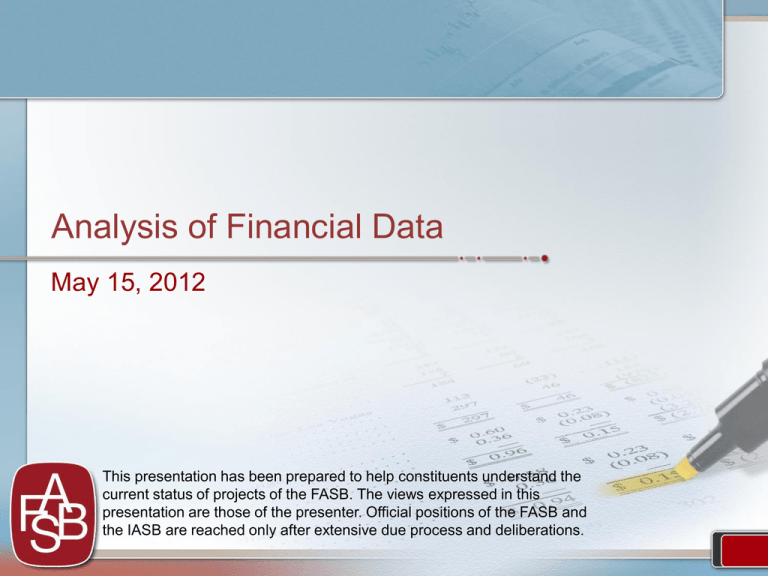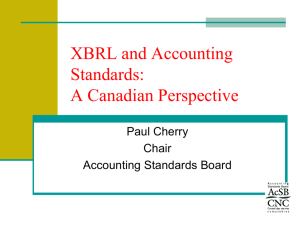Powerpoint slides - Financial Accounting Standards Research
advertisement

Analysis of Financial Data May 15, 2012 This presentation has been prepared to help constituents understand the current status of projects of the FASB. The views expressed in this presentation are those of the presenter. Official positions of the FASB and the IASB are reached only after extensive due process and deliberations. Analysis of Financial Data 2 Current State – XBRL Number of companies filed – Almost 10,000 Number of filings – Over 33,000 Fact values reported – 18 million facts All (except for filers using IFRS) will be detail tagging with June 2012 filing 3 XBRL Data Consumption Various tools for analysis Use of data – internal (filer) − Peer group comparisons − Acquisition targets − Company trends Use of data – external − Buy/sell decisions − Data collection − Research 4 Consistency Suite 5 Consistency Suite Consistency Suite (C Suite) is an XBRL database of SEC-submitted filings, maintained by XBRL US Updated shortly after each filing is submitted to the SEC Free tool for use for anyone with a FAF, FASB or GASB email account Site Address: - http://xbrl.us/research/pages/Csuite.aspx 6 Tools for Analysis 7 XBRL Data Example 1 - XBRL US Tool 2010 filings - Debt by SIC Code 8 XBRL Data Example 1 – XBRL US Tool 2011 filings - Debt by SIC Code 9 XBRL Data Example 1 - XBRL US Tool Data for financial sector further disaggregated 10 XBRL Data Example 2 - XBRL US Tool 2010 filings - Revenue for retail trade sector Wal-Mart has $408,085,000,000 of the $1,894,815,271,079 total for retail trade (22%) 11 XBRL Data Example 2 - XBRL US Tool 2011 filings - Revenue for retail sector, total revenue for sector increased 6% over prior year Wal-Mart has $421,849,000,000 of the $2,023,911,506,915 total for retail trade (21%), increased 3% over prior year 12 XBRL to XL Example 3 13 XBRL to XL Example 3 14 XBRL to XL Example 3 15 Calcbench Example 4 16 Issue: Expected Return on Pension Assets 17 US GAAP Codification 715-20-50-1(k)(3) 18 Link to the UGT 19 Getting to the US GAAP Taxonomy (UGT) 20 Getting to the UGT 21 Getting to the UGT 22 Searching the UGT 23 Navigating the UGT 24 Key: Element Name 25 Log in 26 Run Query 27 Results Exported to Excel 28 Results - Table 2008 2009 2010 2011 2012 Average 7.74% 7.49% 7.34% 7.08% 7.23% Median 8.00% 8.00% 7.75% 7.50% 7.50% Mode 8.00% 8.00% 8.00% 8.00% 7.50% Max 12.30% 12.30% 15.00% 14.25% 9.20% Min 2.50% 1.40% 0.40% 0.24% 3.00% 379 1126 1309 1288 57 Count 29 Fair Value Option 30 Fair Value Option 31 If You Click on the Element in the Cod: 32 Highlight the Element Name & Copy 33 Search for element in the UGT 34 Returns Element 35 C Suite Search Results 36 Standard Setting Considerations 37 Transforming Financial Reporting We are in a paradigm shift from print/PDF to electronic data, but … - The “narrative” is still grounded in presentation - Many still use print statements - Many requirements are set in SEC Rules Our aim is to shift the narrative more towards electronic data to better anticipate change 38 XBRL changes the geography question Three key dimensions - Presentation - Relationships, disaggregation, recognition - Metadata/attributes 39 Revenue Recognition (Topic 605) Proposed Accounting Standards Update (Revised) 69. Upon initial recognition of the receivable, any difference between the measurement of the receivable in accordance with Topic 310 and the corresponding amount of revenue recognized shall be presented in profit or loss as a separate line item adjacent to the revenue line item. If the contract does not have a significant financing component in accordance with paragraph 58, an entity shall present any impairment of the receivable (or change in the measurement of an impairment) in profit or loss as a separate line item adjacent to the revenue line item. 40 OCI - Potential Classification Models Degree of Persistence Core / Non-core Management Control (Stewardship) Remeasurements Degree of Measurement Uncertainty Time Horizon until Realization Operating v. Investing & Financing Other? Instead of classifying, could we just provide the attributes? 41 Disclosure Framework Organization, Formatting, and Style The Board indicated that a Discussion Paper would present a number of ways that a reporting entity could organize information within the notes to the financial statements. Organization of information would not only apply to the ordering of individual notes but also to the information within each note. The Discussion Paper also would provide ideas pertaining to the formatting and style of information in the notes with the intent of establishing clear communication of the information that an entity provides. 42 Organization and Formatting The project will include ways reporting entities can improve the organization and formatting of their disclosures Organization would not only apply to the order of the notes but to the order of the information within the notes Discussion paper will include guidance pertaining to: • Referencing/cross-referencing • Use of headings and tables • Entity specific disclosures 43 Taking advantage of XBRL Encourage tabular disclosures over narrative Deemphasize presentation centric view Identify key attributes that should be disclosed and consider how we can shape the outcome using XBRL 44 Final thoughts A song on iTunes is to an ‘album’ what cash is to assets. If people no longer buy albums and only buy the songs, what does that mean for assets? 45 www.everythingismiscellaneous.com “David Weinberger attacks the complexity of the real world, not by making it simple, but by making it clear. Once he explains how things can be in more than one place at a time-and make sense-you’ll never look at a humble bookshelf or store shelf the same way again.” -- Esther Dyson, author of Release 2.0 46 Questions ? 47






